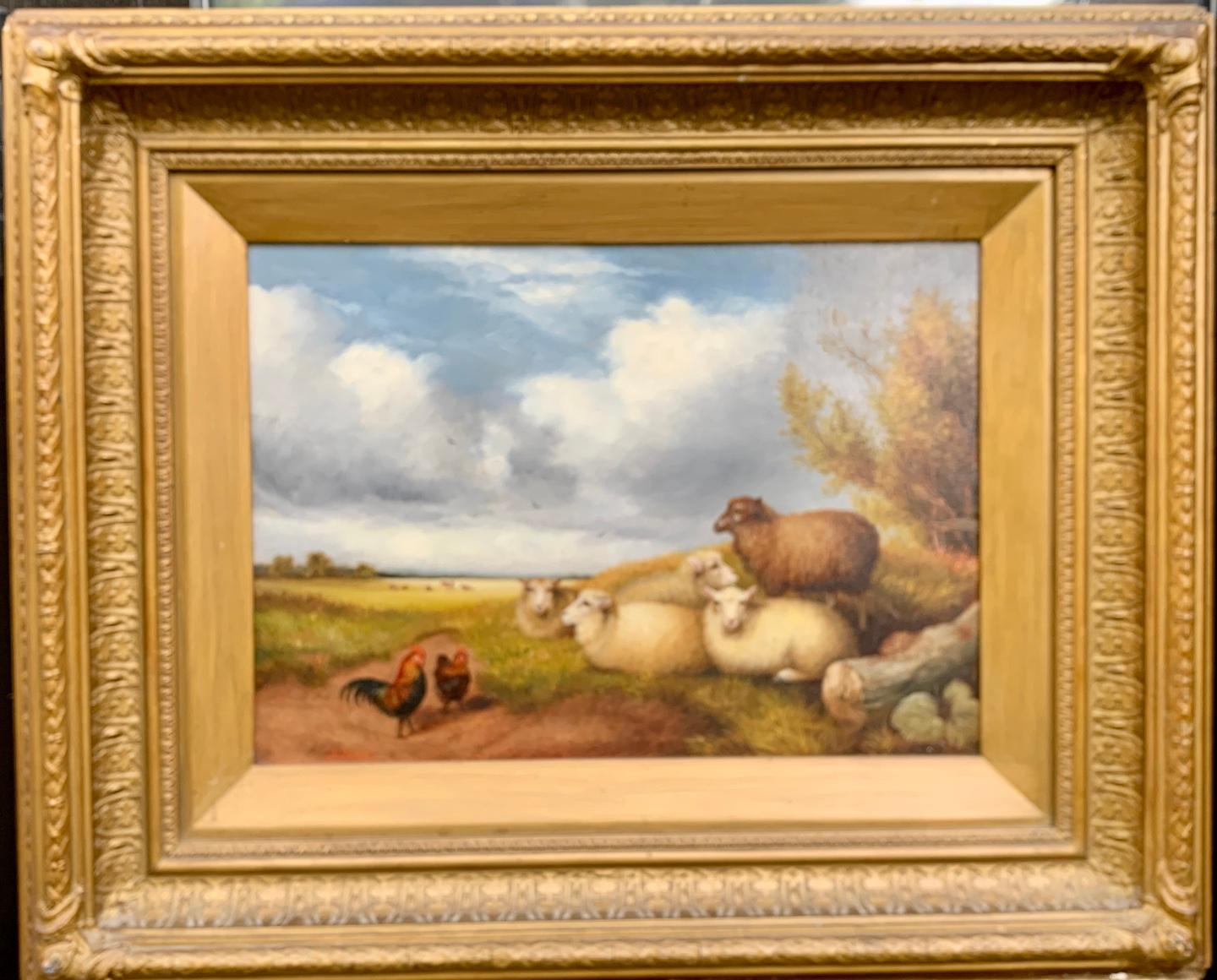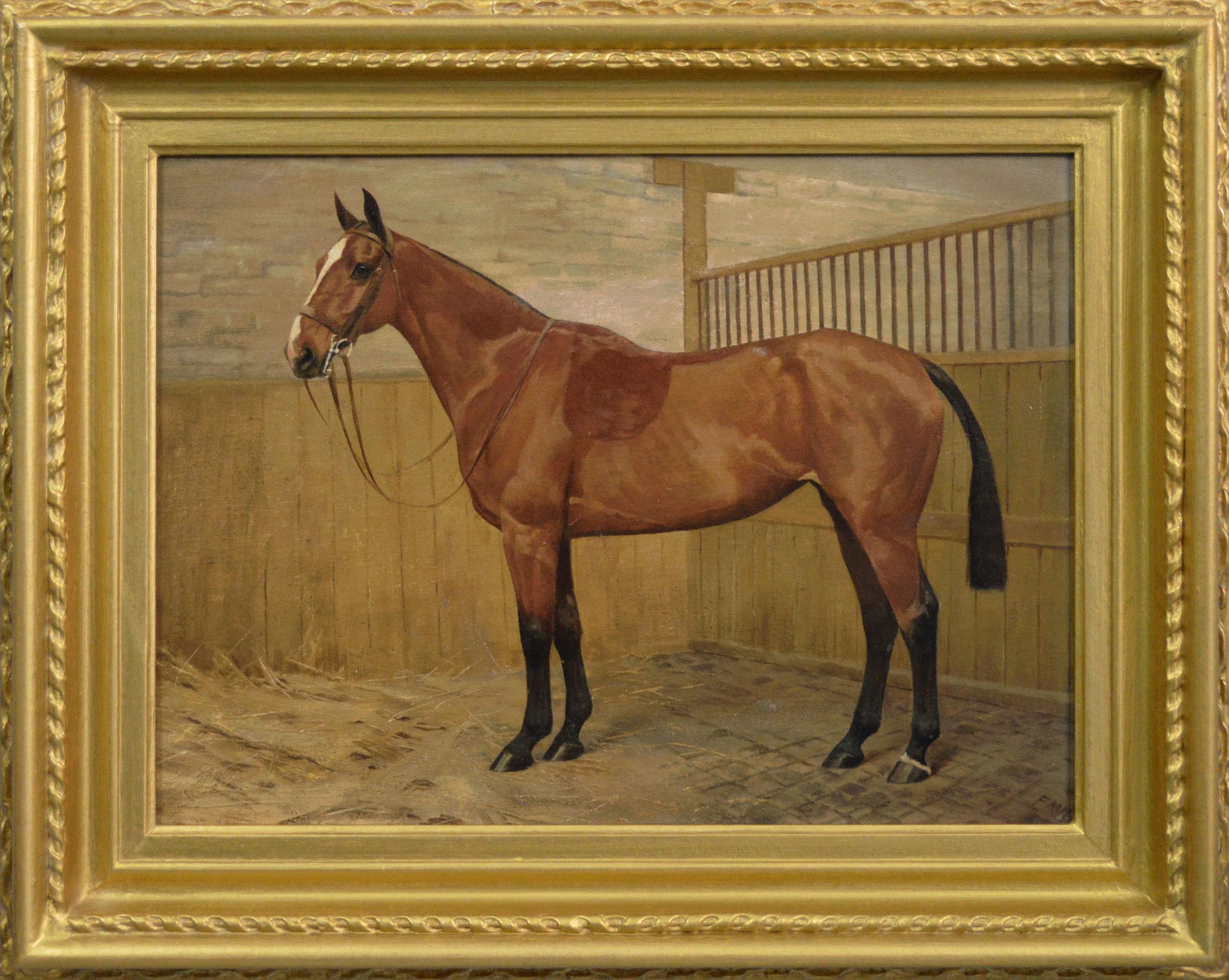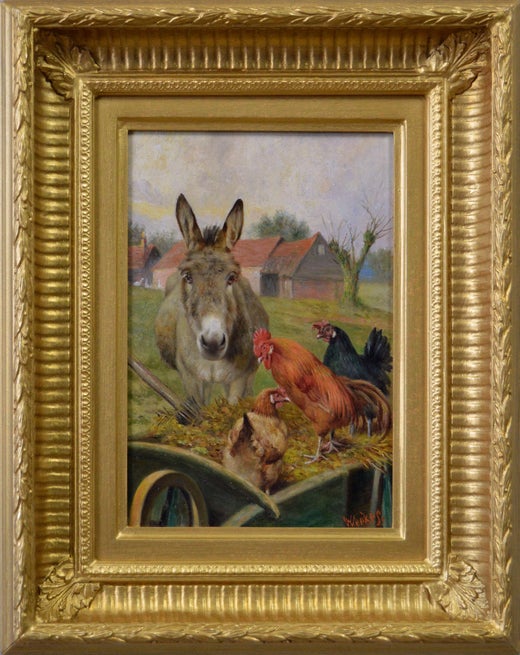Items Similar to 19th Century genre oil painting of a donkey with a cockerel & hens
Want more images or videos?
Request additional images or videos from the seller
1 of 12
Herbert William Weekes19th Century genre oil painting of a donkey with a cockerel & hensC1880
C1880
About the Item
Herbert ‘William’ Weekes
British, (1841-1914)
Farmyard Friends
Oil on panel, signed
Image size: 11.75 inches x 7.5 inches
Size including frame: 18 inches x 14.5 inches
A humorous animal painting of a donkey with a cockerel and hens by Herbert ‘William’ Weekes. The donkey appears to be listening to a conversation between the cockerel and hens who are perched on a wheelbarrow. This human like way of depicting animals was a trademark of the artist.
Herbert William Weekes was born in Pimlico, London on 8 May, 1841 to the sculptor Henry Weekes (1807-1877) and Susan Hammond. He was the brother of the Henry Weekes Jnr (1832-1902) and Frederick Weekes (1834–1924), both of whom were also artists. He lived with his family in Hanover Square and later Belgrave Place in St Pancras and most likely received tuition from his father and older brothers.
He started exhibiting at the British Institution in 1856 under his middle name of William. It is believed he began signing his works with this initial or name presumably to avoid confusion with his father and brother. He made his debut at the Royal Academy in 1865 and in the same year married the artist Caroline Anne Henshaw on 14 October. The couple lived at 129 Prince of Wales Road in St Pancras. He also exhibited at Suffolk Street and many provincial art galleries including the Walker Art Gallery, Royal Birmingham Society of Artists and the Manchester Art Gallery.
By 1879, Weekes had moved to 21 Oppidans Road, Primrose Hill in London where he lived and worked for the rest of his life. In addition to paintings, he also contributed illustrations for The Illustrated London News in 1883. He continued to exhibit at the Royal Academy throughout his life until 1904. He died in Primrose Hill on 21 November, 1914.
Weekes specialised in genre scenes, often painting humorous depictions of animals, posed in very human situations. He was one of a few talented artists who transformed animal painting of the 19th century from a record of beasts to something approaching a reflection of the human condition bringing him a popularity which continues to this day.
Examples of his work can be found in private and public art collections including The Hepworth Museum, Wakefield.
Presentation: The work is housed in a new, English made gilt frame which is in excellent condition.
Condition: As with all of our original antique oil paintings, this work is offered in ready to hang gallery condition, having been professionally cleaned, restored and revarnished.
© Benton Fine Art
- Creator:Herbert William Weekes (1841 - 1914, British)
- Creation Year:C1880
- Dimensions:Height: 18 in (45.72 cm)Width: 14.5 in (36.83 cm)Depth: 2.25 in (5.72 cm)
- Medium:
- Movement & Style:
- Period:
- Condition:
- Gallery Location:Nr Broadway, GB
- Reference Number:1stDibs: LU156213902752
Herbert William Weekes
Herbert William Weekes was born in London, UK, in 1841. He was a well-known English genre and animal painter of the Victorian Neoclassical period who specialized in portraying animals in humorous human-like situations.
About the Seller
4.9
Platinum Seller
These expertly vetted sellers are 1stDibs' most experienced sellers and are rated highest by our customers.
Established in 1972
1stDibs seller since 2015
272 sales on 1stDibs
Typical response time: <1 hour
Associations
The British Antique Dealers' AssociationLAPADA - The Association of Arts & Antiques DealersInternational Confederation of Art and Antique Dealers' Associations
- ShippingRetrieving quote...Ships From: Nr Broadway, United Kingdom
- Return PolicyA return for this item may be initiated within 3 days of delivery.
More From This SellerView All
- Horse portrait oil painting of a bay hunter in a stableBy Florence Mabel HollamsLocated in Nr Broadway, WorcestershireFlorence Mabel Hollams British, (1876-1963) A Bay Hunter Oil on panel, signed with initials Image size: 11.5 inches x 15.75 inches Size including frame: 17 inches x 21.25 inches A b...Category
20th Century Victorian Animal Paintings
MaterialsPanel, Oil
- 19th Century genre oil painting of two donkeys with a turkeyBy Herbert William WeekesLocated in Nr Broadway, WorcestershireHerbert ‘William’ Weekes British, (1841-1914) A Chat over the Fence Oil on panel, signed Image size: 11.25 inches x 7.5 inches Size including frame: 16.5 inches x 12.75 inches A hu...Category
19th Century Victorian Animal Paintings
MaterialsOil, Panel
- 19th Century landscape oil painting of cattle & sheep in the HighlandsBy Charles Jones (b.1836)Located in Nr Broadway, WorcestershireCharles Jones British, (1836-1892) Cattle & Sheep in the Scottish Highlands Oil on panel, signed with monogram & dated (18)75, further inscribed verso Image size: 19.75 inches x 15.75 inches Size including frame: 26.75 inches x 22.75 inches A dramatic Scottish landscape painting of Highland Cattle and Sheep by Charles ‘Sheep’ Jones...Category
19th Century Victorian Animal Paintings
MaterialsOil, Panel
- Pair of landscape hunting scenes with wild boarLocated in Nr Broadway, Worcestershire**PLEASE NOTE: EACH PAINTING INCLUDING THE FRAME MEASURES 17 INCHES X 20 INCHES** Godfrey Douglas Giles British, (1857-1941) Wild Boar & her Young in an Indian Landscape & Pursuit o...Category
Early 20th Century Victorian Animal Paintings
MaterialsPanel, Oil
- 19th Century landscape oil painting of sheep in a Sussex laneBy William Luker Sr.Located in Nr Broadway, WorcestershireWilliam Luker Snr British, (1828-1905) Sheep in a Sussex Lane with Pevensey Bay in the distance Oil on canvas, signed & dated 1875 Image size: 17.25 inches x 25.25 inches Size including frame: 23.25 inches x 31.25 inches A tranquil landscape scene of a shepherd and his flock resting in a lane near Pevensey Bay, Sussex by William Luker. The ruins of Pevensey Castle can be seen in the distance with the sea beyond. William Luker Snr was born in 1828 at Faringdon, Berkshire to William and Jane Luker (née Charlwood). His father was a plumber and glazier by trade and the family lived at London Street in Faringdon. Little is known about his early education and it is believed for the most part he was self -taught. However, given the quality of his work and the fact that his family were able to keep a servant, he may well have received some artistic tuition. By the early 1850’s, he had begun earning a living as an artist by advertising in local directories, earning commissions from local landowners. He made his debut at the Royal Society of British Artists in 1851 and was a prolific exhibitor there for over 40 years. He began exhibiting at the Royal Academy in 1852 and also exhibited at the British Institution. He married the artist Ada Augusta Margetts (1839-1930) on 27 October 1864. Their eldest son William Luker Jnr (1867-1951) also became a well-known artist. The couple soon moved to London where they lived at 22 Gloucester Terrace, Campden Hill from where they both exhibited. From 1867, they lived at 15 Sheffield Terrace in Kensington until 1874 when they moved for the final time to 22 Notting Hill Square, later renamed Campden Hill Square in 1893. He died at Campden Hill-square on 28 February, 1905. Luker specialised in landscapes featuring animals such as sheep and cattle, horses and deer. He travelled around visiting areas such as Sussex, Buckinghamshire, Kent, Wales and the Highlands. However, he also made trips to Egypt and Libya producing a series of Oriental scenes in the early 1860’s. His works show a great attention to detail and his use of a lighter palette gives his subjects a luminous quality that instantly attracts the viewer. Examples of his paintings are held by the Atkinson Art Gallery, National Library of Wales, Newstead Abbey...Category
19th Century Victorian Animal Paintings
MaterialsCanvas, Oil
- 19th Century Highland landscape oil painting of sheep near Loch AweLocated in Nr Broadway, WorcestershireWilliam Watson Jnr British, (1847-1921) On the Mountains, Loch Awe Oil on canvas, signed & dated 1892, further inscribed verso Image size: 12.5 inches x 18.5 inches Size including frame: 18.5 inches x 24.5 inches A wonderful painting of Highland sheep resting near Loch Awe by William Watson Jnr. Loch Awe is located in Argyll and Bute in the Scottish Highlands and this scene is taken from the mountain side overlooking the loch. William Watson was born in Islington in 1847, the son of the London miniature painter William John Watson (1810-1871) and his wife Caroline (née Butcher). His brothers Charles Watson (1837-1900) and Robert Watson (1855-1921) were also artists. His father seems to have travelled around and after spending time in Brighton, the family moved to Bransford Road in Worcester during the early part of the 1860’s. As well as being taught by his father, Watson received his early training in the studio of Sir Francis Grant PRA (1803-1878). He later became a pupil of Sir Edwin Henry Landseer RA (1802-1873) and Rosa Bonheur (1822–1899). Both Landseer and Bonheur had a great influence on his work and he began specialising in scenes of cattle and sheep. By 1866 he had become a full time artist and began exhibiting at the Royal Society of British Artists. Perhaps to take advantage of the inspiring scenery, Watson moved to Birkenhead, Cheshire where in 1871 he met and married Eleanor Davies who was from Caernarvonshire. Four of their children Sidney Watson (1881-1931), Caroline Ellen...Category
19th Century Victorian Animal Paintings
MaterialsCanvas, Oil
You May Also Like
- French 19th century Chickens in a barn or chicken coop interiorBy Charles-Emile JacqueLocated in Woodbury, CTFrench 19th century Chickens in a barn or Chicken coop interior Charles-Emile Jacque (23 May 1813 – 7 May 1894) was a French painter of animals ...Category
1870s Victorian Animal Paintings
MaterialsOil, Wood Panel
- 19th century English portrait of a dog with her PuppiesLocated in Woodbury, CTH.Jackson. 19th century English landscape with sheep English late 19th-century painter of animals either in barns or landscapes. His paintings have the influence of the work of the Belgium painter Cornelius van Leemputten...Category
1890s Victorian Animal Paintings
MaterialsOil, Panel
- 19th century English portrait of a dog with her PuppiesLocated in Woodbury, CTH.Jackson. 19th-century English landscape with sheep resting in a field. English late 19th-century painter of animals either in barns or landscapes. His paintings have the influence of the work of the Belgium painter Cornelius van Leemputten...Category
1890s Victorian Animal Paintings
MaterialsOil, Panel
- Antique 19th century English, pair of Huntsman riding with hounds in a landscapeBy John Frederick Herring JrLocated in Woodbury, CTJohn Frederick Herring Junior, Antique 19th century English, pair of Huntsman riding with hounds in a landscape. John Frederick Herring Jnr. was a painter of sporting and animal s...Category
1860s Victorian Animal Paintings
MaterialsOil, Wood Panel, Canvas
- Wonderful Victorian oil of cows grazing in the Welsh or English hillsLocated in Harkstead, GBAn idyllic view of cattle and sheep grazing in a pasture before an oak tree with a blue sky with bollowing clouds beyond. William S Rose (1810-1873) Cattle and sheep grazing in rou...Category
Mid-19th Century Victorian Landscape Paintings
MaterialsOil, Wood Panel
- French 19th century Chickens in a landscapeBy Charles-Emile JacqueLocated in Woodbury, CTFrench 19th century Chickens in a landscape Charles-Emile Jacque (23 May 1813 – 7 May 1894) was a French painter of animals (animalier) and engr...Category
1870s Victorian Animal Paintings
MaterialsOil, Wood Panel
Recently Viewed
View AllMore Ways To Browse
This Week
Oil Painting Genre
Antique Week
Oil Paintings Genre Scenes
19th Century Genre Painting
19th Century Oil Painting Of Family
19th Century Oil Paintings Genre
Oil Painting Of Wales
Paintings By William Henry
Royal Provincial
Dior Hills
Royal Presentation Frame
Genre British
British Genre Paintings
Donkey Art
Humorous Oil Painting
19th Century Painting Couple
Donkeys In Art






